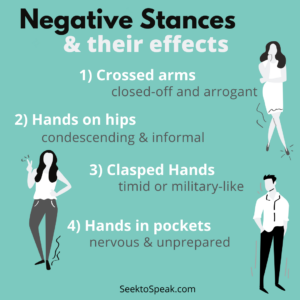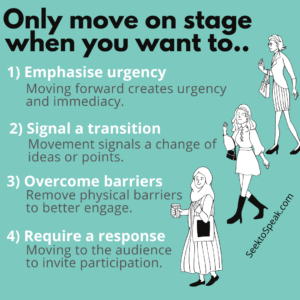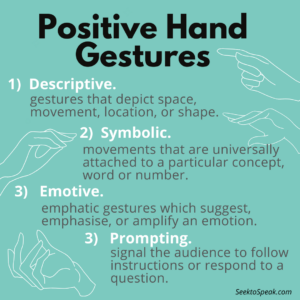With most parts of the world still on lockdown and most social interaction remaining online, there is a distinct lack of physical human contact in our lives. Even with all the emojis in the world, the emotions conveyed online are nowhere near as genuine as those expressed in real life and in real-time.
Body language is a powerful rhetorical tool — the tiniest of gestures can have a significant impact on our speeches. In this article, we will discuss the use of hand gestures, how you should present yourself, and when to move on a stage.
Hand gestures: the good, the bad, the dramatic
Similar to how facial expression and intonation brings life to your face and voice, hand gestures give colour to your body language. When done right, they transform your speech.
Positive hand gestures are those that complement and reinforce your message, not detract from it. There are four types of positive gestures: descriptive, symbolic, emotive, or prompting.
1. Descriptive.
These are gestures that depict space, movement, location, or shape. Descriptive gestures help the audience visualise the concept or story you are telling. For example, opening your arms wide shows length or distance. Swinging your hands may show flow while making a box with your fingers illustrates a square.
2. Symbolic.
Also known as suggestive gestures, these are hand movements that are universally recognised or attached to a particular concept, instruction, word, number, or position. For example, a thumbs-up shows support or agreement while a raised open palm signals attention or a halt. Pointing indicates a position while showing four fingers out implies the number 4.
3. Emotive.
Emotional or emphatic gestures suggest, emphasize, or amplify a feeling, sentiment, or emotion. For example, clasped hands can show sadness, while clenched fists can indicate anger. Open palms can show surrender or raised shoulders illustrates exasperation.
4. Prompting.
These gestures signal the audience to mimic a movement, follow instructions, or respond to a question. For example, having one hand out to an audience prompts them to answer a question while clapping your hands invites the audience to do the same.
Nevertheless, even positive gestures should look natural and organic. While done with intention, these gestures shouldn’t look too staged. Your movements shouldn’t be dramatic or excessive for the following reasons:
1. Dramatic.
Being expressive is not the same as being theatrical. You should deliver a speech, not act out a script. Ensure that your hands stay within the “box” that consists of the space between your waist and shoulder. Any gesture that goes outside of this “box” is likely to be distracting and look insincere. So no jazz hands, yeah?
2. Excessive.
Sometimes, less is more. There is no need to gesture at every word in every sentence. You are not speaking a language through your movements. Your gestures are merely complementing the primary mode of presentation, which is the use of your words!


You shouldn’t just be aware of your hand gestures. Your appearance and posture should also be something you take into account.
Do I look okay? Am I standing correctly?
Imagine a speaker jogging onto the stage with a big smile, looking smart in her tailored suit, standing straight and confidently on the stage. Even before she speaks, you already like her and are likely going to be more receptive to her ideas.
How you look and how you carry yourself is extremely important in developing credibility and likeability. Coming on stage wearing informal clothing and slouching at the podium will make a poor first impression. The audience should view you positively the moment you step onto the stage. Therefore, please take care of how you look and what you wear on the day of your speech. You should present yourself as someone who is trustworthy and professional.
Similarly, your posture shouldn’t attract attention either. Don’t slouch or crouch. Your stance on stage should signal “comfortable authority” — that is, a state of being relatable and sincere, yet authoritative and competent. You should stand straight but with your arms relaxed in a natural but “ready” position. Your feet should be slightly apart and facing forward. From the side, your body should look like a straight line, with the balls of your feet, waist, shoulders, and head, all in alignment.
It is human nature to cover up your vital organs if you feel threatened or anxious. That’s why speakers tend to cross their arms when they feel nervous and exposed.


However, this type of disposition makes you look closed-off and arrogant. Having your arms relaxed at your sides will make you seem more open and approachable. Other stances you should avoid are:
1) Hands on your hips, on one side, or both sides. Having your hands on your hips makes you look condescending, almost parental even — like you’re about to give your audience a scolding. It also seems too informal for a speech setting.
2) Hands clasped in front or behind your back. Clasped hands to the back look almost military-like, as if you’re marching in a parade. Inversely, hands clasped in front of you makes you look weak or timid.
3) Hands in your pockets or wringing in front of you. Wringing your hands or stuffing them in your pockets makes you look nervous and unprepared. These are typically involuntary, arising from a need to do something with your hands.


Now that you know what to do with your hands, you may be thinking where your feet should go. Is it okay to move around on stage?
Body movement: does it distract from or complement your speech?
The general rule is that you should only move purposefully and with intention. Involuntary movements, like rocking back and forth on stage, are typically distracting and would take the audience’s attention away from your message. In response, your listeners may start asking themselves, Is he nervous? Why does he keep moving? Wow, he’s pretty tall, isn’t he? Your body language should work in tandem with your message, not cloud it.


Apart from hand gestures, body movement is only acceptable when used to achieve the following objectives:
1. Emphasize urgency: Moving forward to be closer to your audience at the climax of your speech or to conclude a point helps create a sense of urgency and immediacy to the issue you are highlighting. It does this by developing a sudden closeness in proximity between you and your listeners, making them pay close attention.
2. Signal a transition: Moving from one side of the stage to another as you transition between ideas is an excellent way to use movement as a signal for the audience to clue-in to new content. This method is usually done by stand-up comics who move on stage in between “bits” (a small collection of related jokes and anecdotes). It’s also a great way to change the tone of your speech, especially when you’re about to switch delivery styles to invite reflection.
3. Overcome barriers: During your speech, if you find that your lectern, mic stand or podium acts like an obstacle from better communicating with your audience, feel free to move these physical barriers away by stepping forward. Should the audience only be seated in the back rows of the hall, consider stepping off the stage altogether to better engage with your listeners.
4. Require a response: Magicians often do this when they ask for volunteers, sometimes even going right into the audience to pick an unwilling participant. Speakers do this much less. Questions asked in a speech are usually rhetorical and doesn’t require an answer. However, if participation is needed, a speaker may move into the audience to ask a question or seek a volunteer.


